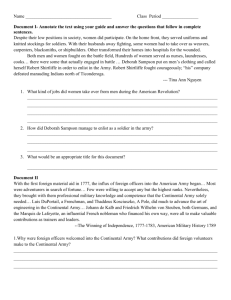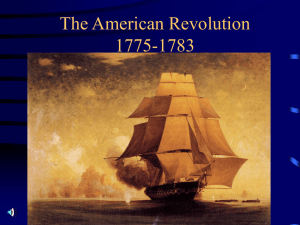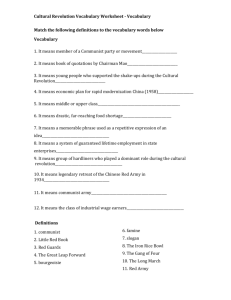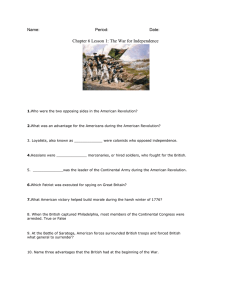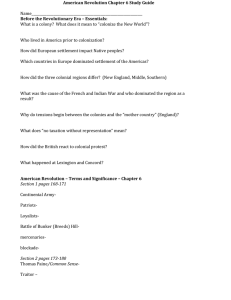Key Battles/Events of the American Revolution
advertisement
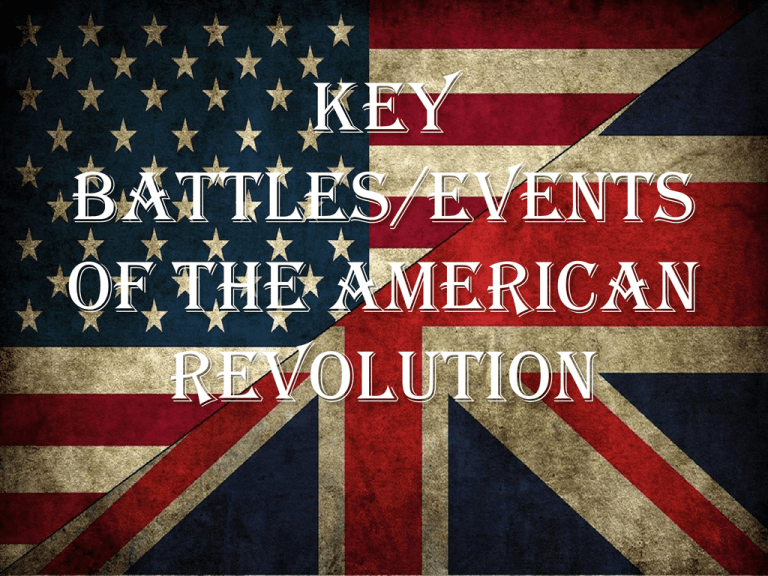
Key Battles/Events of the American Revolution Advantages • British: 1. Best army and navy in the world 2. Well trained troops 3. Well supplied 4. More military experience • American: 1. 2. 3. 4. Better leadership Foreign Aid Knowledge of the land Motivation=Independence The Leaders: • George WashingtonCommander of the Continental Army • General CornwallisCommander of the British (Redcoat) Army • King George III- King of England 1. Lexington and Concord • 1775 • 1st Shot in the American Revolution • “Shot heard ‘round the world” 2. Battle of Bunker Hill • 1775 • Though the colonist lost they were able to hold their own against the most powerful army in the world. • Gave the colonists confidence. They realized the war may be long but they could win. – “Don’t shoot until you see the whites of their eyes.” 3. The Crisis • Thomas Paine-author • Written to boost the spirits of the Continental Army • Had suffered several loses and were low on supplies • Washington read the pamphlet out loud to his soldiers “These are the times that try men’s souls. The summer soldier and the sunshine patriot will, this this crisis, shrink from the service of their country; but he that stands it now, deserves the love and thanks of man and woman.” - Thomas Paine, The American Crisis Battle of Trenton • Washington hoped a victory would encourage his men. – He also knew that he needed to attack quickly before his most of his soldiers enlistments ended. • December 25, 1776 – Crossed the Delaware River into Trenton, NJ – An early morning surprise attack – Killed or captured more than 900 British (Hessian) soldiers and gained supplies 4. Battles of Saratoga • 1777 – 2 battles fought 18 days apart • Turning Point in the American Revolution • The victory helped Franklin to convince France to send aid ($$$) and troops (Marquis de Lafayette) 5. Winter at Valley Forge • Winter 1777-78 – A time of suffering • Americans lost 2,000 due to disease, lack of clothing, food, etc. • 2,000 deserters – A time for endurance/dedication • Intense training, drilling • Foreign Help – Marquis de Lafayette – Baron Von Steuben Marquis de Lafayette • 20 year old, wealthy French officer • Inspired by the Patriot cause, he volunteered for the Continental Army – Requested no pay • First arrived in June 1777, fought at Brandywine • Would give $200,000 of his own to support army • Would become close friends with Washington – Washington thought of him like a son • Would be promoted to Major General and play a large part in the American army The Baron Friedrich Wilhelm Ludolf Gerhard Augustin von Steuben • Baron Von Steuben – Spoke no English – Supposed high ranking Prussian officer – Offered his services for no pay – Demanded respect; feared – Washington made him Inspector General of the Army – In charge of training and sanitation – Later found out to be a fake • Didn’t matter George Washington and Lafayette at Valley Forge by John Ward Dunsmore 6. Naval Battles • Privateer-a privately owned ship that a wartime government gives permission to attack enemy ships. • 1,000s of colonial privateers • Continental Navy – John Paul Jones- naval officer that defeated a British naval ship. • “I have not yet begun to fight” * 7. Battle of Yorktown • 1781 • Last battle in the American Revolution – American and French troops surrounded the Redcoats. – British (Cornwallis) surrendered in 1781 to America (Washington) Other Key People: • Bernardo de Galvez- Spanish governor of Louisiana that helped the Patriots during the American Revolution (Galveston is named after him) • James Armistead- A spy who pretended to be a runaway slave that gave Washington many British War secrets • Haym Salomon- A Jewish immigrant who helped America finance the American Revolution • Wentworth Cheswell- African American who fought for Independence and later became the 1st African American elected to public office in America Haym Salomon Bernardo de Galvez Wentworth Cheswell James Armistead 8. Treaty of Pairs (1783) • Official end to American Revolution • Terms of Treaty: 1. U.S. was independent 2. Set boundariesMississippi River(West); Canada (North); Spanish Florida (South) 3. All sides would repay debts 9. Cost of War • 25,700 Americans dead and 1400 remained missing • 8,200 Americans wounded • 10,000 British deaths • $27 million in war debt

